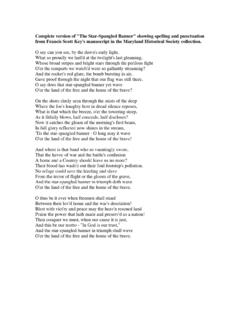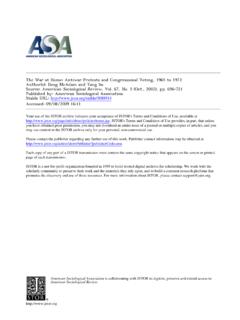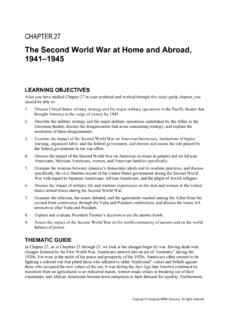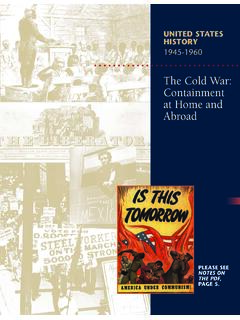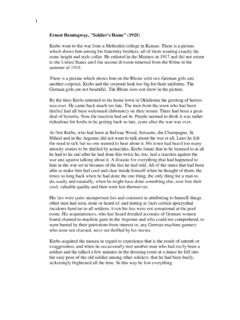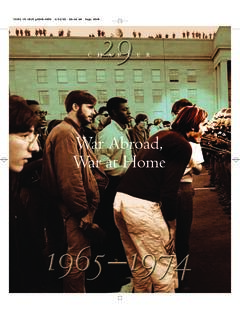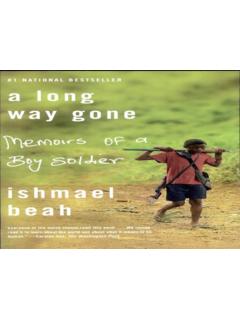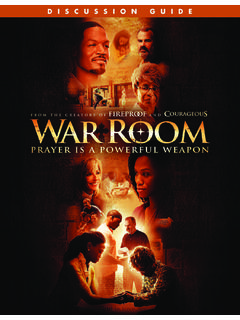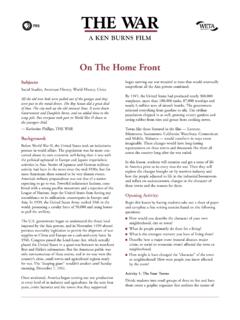Transcription of Section IV: World War II - Home | National Museum of ...
1 Title: Changing Gender Roles on the home FrontGrade Level: Middle/High SchoolObjectives: Conduct historical research using the Museum s collections of Rosie theRiveter artifacts and images. Analyze how World War II changed genderroles in society. Determine the societal impact of females holdingindustrial jobs during the war (numbers involved, effect on otherrelationships in society). National History Standards: Standards 4: Student Research Capabilities; Era 8:3: The causes andcourse of World War II, the character of the war at home and abroad,and its reshaping of the role in World : 45 minutes to introduce the project, plus in-class work time and anyadditional lessons on conducting historical researchBackground: By the time the United States entered World War IIin 1941, American defense industries were alreadychurning out large numbers of planes and ships,trucks and tanks, guns and shells, supplies andequipment.
2 Tons of war materials were beingshipped to Britain and other nations battling theAxis. As America joined the f ight, and battlefrontsmultiplied around the globe, demands on warproduction skyrocketed. Civilian industries re-tooled,manufacturing tanks instead of cars, parachutesinstead of stockings, machine guns instead ofKleenex. And as men went off to war, six millionwomen took their places on factory floors andassembly lines. American industry and American workers producedmost of the war mat riel the United States and someforty other nations used to f ight the war: 324,000 aircraft, 88,000 tanks, 8,800 warships,5,600 merchant ships, 224,000 pieces of artillery,2,382,000 trucks, 79,000 landing craft, 2,600,000machine guns, 15,000,000 guns.
3 42the price of freedom: americans at wargender roles on the home frontSection IV: World War IILESSON 10 Womanwar workercoverallsNationalMuseum ofAmericanHistorygender roles on the home frontthe price of freedom: americans at war 43 I worked the graveyard shift 12:00 8:00 , in the shipyard. I had leather gloves, leatherpants, big hood, goggles, and aleather jacket. They said you weldlike you crochet. Katie GrantWoman welder Courtesy of National Archives Welding mask NationalMuseum of American History44 Mater ials:Online Vid eo World War II Overview: North Atlantic and North AfricaWoman war worker coveralls Maidenform ad: Brassieres.
4 A Vit al Necessity to Women at Work Welding mask used by ship welder Augusta Clawson African American woman welding Women riveting Lesson:This le sson should gi ve st udents a dierent perspectiveon the eects of World War II. It provides an excellenttopic for a cl ass-wide, semi-guided research proj ectthat teaches st udents how to do in -depth historicalresearch. This will prepare them for the ty pes ofprojects they will have to conduct in college. Fir st, set the st age by showing the students the WorldWar II overview of the North Atlantic and NorthAfrican theaters on the video.
5 Then have them writ edown the st eps they would take to research a topic onthe impact on society of the Rosie the Rivetercampaign. (Steps should include: establishing a thesis,developing a process to prove the thesis, reviewingsecondary sources, analyzing primary sources, andtesting the accuracy of the thesis.) Make sure students use a var iety of sources, both primary and secondary. Have themanalyze images and artifacts in the manual fr om the National Museum of AmericanHistory collections, as well as review library primary accounts about female should supplement this analysis with st atistical data fr om the census;ask them to nd out the numbers of female workers and compare this to totals beforethe war.
6 Also, have the students compare their ndings to the theses of otherhistorians. Encourage them to be cr itical of what others have concluded in the past. Follow-up Activity:Students may know of women in their local community who recall lif e in Americaduring World War II. Some of these women may be willing to say how they feel aboutthe changes in society that occurred during their youth. This would introduce studentsto the skill of interviewing in addition to providing an eyewitness perspective to theircurrent research project.
7 Students could research the impact of the need for workers on African Americans orAmerican immigrants, particularly the Hispanic population. How did the newopportunities to work aect their lives?L E S S O N 10T H E P R I C E O F F R E E D O M : A M E R I C A N S A T W A RG E N D E R R O L E S O N T H E H O M E F R O N TWomen rivetingCourtesy of National ad National Museum of American HistoryGeneralDaso, Dik, ed., with Howard Morrison and David Allison. The Price of Freedom: Americans at Books, I: War of IndependenceBrenner, Barbara.
8 If You Were There in Press, , John R. The Minute Men: The First Fight Myths and Realities of the American Books, , Albert. George Washington and the Founding of a Children s Books, , Milton. The American Revolutionaries: A History in Their Own Words 1750 , , Arthur B. Lexington and Concord: The Beginning of the War of the American Revolution. W. W. Norton, , Nancy. The Shot Heard Round the World : The Battles of Lexington & Concord. Morgan Reynolds, II: Wars of ExpansionBachrach, Deborah. Custer s Last Stand: Opposing Press, , Carol and Thomas.
9 The Books, , Angela M. Beyond the Mississippi: Early Westward Expansion of the United , , Albert. Tatan ka Iyota ke: Sitting Bull & His World . Dutton Chidren s Books, III: Civil WarBetter, Susan Provost. Billy Yank and Johnny Reb: Soldiering in the Civil War. Twenty-First Century, , Ina. A Separate Battle: Women & the Civil War. Lodestar Books, , Brown: One Man Against , , James M. Fields of Fury: The American Civil War. Simon & Schuster/Atheneum, Milton. Voices from the Civil War: A Documentary History of the Great American Conflict.
10 HarperCollins, , Jim. The Boy s War. Confederates & Union Soldiers Talk about the Civil Books, , Catherine. Civil War Soldiers: African-American Century, IV: World War IIBachle, Rosemary Eckroat. Women s War Heritage Books, 1999. DeLee, Nigel. Voices from the Battle of the Bulge. David and Charles, , Sherna Berger. Rosie the Riveter Revisited: Women, the War, and Social , 1987. Green, Gladys and Michael. Patton and the Battle of the International, , Judith Pinkerton. Growing Up in World War II 1941 Publications, , Tim.
